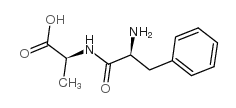Phe-Ala

Phe-Ala structure
|
Common Name | Phe-Ala | ||
|---|---|---|---|---|
| CAS Number | 3918-87-4 | Molecular Weight | 236.26700 | |
| Density | 1.222g/cm3 | Boiling Point | 506ºC at 760mmHg | |
| Molecular Formula | C12H16N2O3 | Melting Point | 241℃ (Decomposition) | |
| MSDS | Chinese USA | Flash Point | 259.8ºC | |
|
Alkali metal complexes of the dipeptides PheAla and AlaPhe: IRMPD spectroscopy.
ChemPhysChem 9 , 579-589, (2008) Complexes of PheAla and AlaPhe with alkali metal ions Na(+) and K(+) are generated by electrospray ionization, isolated in the Fourier-transform ion cyclotron resonance (FT-ICR) ion trapping mass spectrometer, and investigated by infrared multiple-photon diss... |
|
|
Single-conformation ultraviolet and infrared spectroscopy of model synthetic foldamers: beta-peptides Ac-beta3-hPhe-beta3-hAla-NHMe and Ac-beta3-hAla-beta3-hPhe-NHMe.
J. Am. Chem. Soc. 130(14) , 4795-807, (2008) The conformational preferences and infrared and ultraviolet spectral signatures of two model beta-peptides, Ac-beta3-hPhe-beta3-hAla-NHMe (1) and Ac-beta3-hAla-beta3-hPhe-NHMe (2), have been explored under jet-cooled, isolated-molecule conditions. The mass-re... |
|
|
A novel inhibitor of the mammalian peptide transporter PEPT1.
Biochemistry 40(14) , 4454-8, (2001) This study was initiated to develop inhibitors of the intestinal H(+)/peptide symporter. We provide evidence that the dipeptide derivative Lys[Z(NO(2))]-Pro is an effective competitive inhibitor of mammalian PEPT1 with an apparent binding affinity of 5-10 mic... |
|
|
P3 cap modified Phe*-Ala series BACE inhibitors.
Bioorg. Med. Chem. Lett. 14(1) , 245-50, (2004) With the aim of reducing molecular weight and adjusting log D value of BACE inhibitors to more favorable range for BBB penetration and better bioavailability, we synthesized and evaluated several series of P3 cap modified BACE inhibitors obtained via replacem... |
|
|
Dipeptide transport characteristics of the apical membrane of rat lung type II pneumocytes.
Am. J. Physiol. 269(2 Pt 1) , L137-43, (1995) The transport of a hydrolysis-resistant dipeptide, D-phenylalanyl-L-alanine (D-Phe-L-Ala), has been studied by high-performance liquid chromatography in rat lung epithelial cells and apical membrane vesicles. Time-dependent uptake of D-Phe-L-Ala into isolated... |
|
|
Expression and functional characterization of the mammalian intestinal peptide transporter PepT1 in the methylotropic yeast Pichia pastoris.
Biochem. Biophys. Res. Commun. 232(3) , 656-62, (1997) The methylotrophic yeast Pichia pastoris was used for heterologous expression of the rabbit intestinal peptide transporter PepT1 and its functional characterization. PepT1 mediates the electrogenic transmembrane transport of di- and tripeptides and peptido-mi... |
|
|
Analgesic properties of N-terminal substituted phenylalanyl-alanine.
Life Sci. 33(16) , 1575-80, (1983) Phenylalanylalanine, an in vitro inhibitor of enkephalinase, and some of its N alpha-derivatives are shown to possess an analgesic action when injected i.p. and i.c.v. into mice in the presence or absence of Leu5-enkephalin. In the second case a synergistic r... |
|
|
Functional and molecular characterization of a peptide transporter in the rat PC12 neuroendocrine cell line.
FEBS Lett. 508(3) , 350-4, (2001) We have studied functional properties of peptide transport in the pheochromocytoma neuroendocrine cell line from rat. The neutral peptide D-Phe-L-Ala (resistant to hydrolysis) is a good substrate for uptake into these cells. Transport is substantially inhibit... |
|
|
Functional expression of the peptide transporter PEPT2 in the mammalian enteric nervous system.
J. Comp. Neurol. 490(1) , 1-11, (2005) The peptide transporter PEPT2 mediates transmembrane uptake of small peptides. So far, its expression has not been evidenced in the gastrointestinal tract. We have investigated peptide transport activity in the neuromuscular layers of the gastrointestinal tra... |
|
|
Cationized phenylalanine conformations characterized by IRMPD and computation for singly and doubly charged ions.
Phys. Chem. Chem. Phys. 12 , 13383-13393, (2010) Electrospray ionization produces phenylalanine (Phe) complexes of the alkali metal ion series, plus Ag(+) and Ba(2+). Infrared multiple photon dissociation (IRMPD) spectroscopy using the FELIX free electron laser light source is used to characterize the confo... |